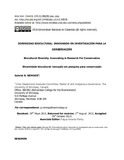| dc.contributor.author | Nemogá, Gabriel R. | |
| dc.date.accessioned | 2018-04-02T22:02:57Z | |
| dc.date.available | 2018-04-02T22:02:57Z | |
| dc.date.issued | 2016 | |
| dc.identifier.citation | Nemogá, Gabriel R. "Biocultural Diversity: Innovating in Research For Conservation." 2016. | en_US |
| dc.identifier.uri | http://hdl.handle.net/10680/1453 | |
| dc.description | Author's translation of: Nemogá GR. Diversidad biocultural: innovando en investigación para la conservación. Acta biol. Colomb. 2016; 21(1) Supl:S311-319. doi:10.15446/abc.v21n1sup.50920. | en_US |
| dc.description.abstract | The conservation of biodiversity may be deemed ethical and more effective by focusing simultaneously on biological and cultural erosion. This idea was in the functional and ethical principles of the initial understanding in conservation biology. However, biological conservation research has emphasized inventories, quantification and georeferencing biodiversity with utilitarian purposes. Such research gives little importance to the intrinsic value of biodiversity provoking calls to explore appropriate ways of "living with" biodiversity. This paper responds to that call. The biocultural approach offers a more comprehensive view to recognize and investigate the complex interrelationships between ecological processes and cultural dynamics. For research, this approach highlights the need to recognize the rights of indigenous peoples and local communities, as well as the community worldviews that infuse meaning to community practices and relations with the environment. This paper explores biodiversity research data involving traditional knowledge and communities during the period 1991- 2010 in the GroupLac Database. Given the limited recognition to the contributions of communities, this paper outlines the main barriers that the adoption of the biocultural approach faces. The paper proposes ethical guidelines to transform research attitudes and practices that ignore ancestral rights over the territory and traditional knowledge, hinder the recognition of the intrinsic value of biodiversity, and as a result, prevent conservation in a biodiverse, multi-ethnic and multicultural territory. | en_US |
| dc.description.sponsorship | The English version was supported by University of Winnipeg funding and the work of Laura J. Nemogá and Natalie Bartmes, both students at this University. | en_US |
| dc.description.uri | https://revistas.unal.edu.co/index.php/actabiol/article/view/50920 | |
| dc.language.iso | en | en_US |
| dc.rights | info:eu-repo/semantics/openAccess | |
| dc.subject | Biodiversity | en_US |
| dc.subject | Colombia | en_US |
| dc.subject | Traditional knowledge | en_US |
| dc.subject | Indigenous peoples | en_US |
| dc.subject | Research ethics | en_US |
| dc.title | Biocultural Diversity: Innovating in Research For Conservation | en_US |
| dc.type | Article | en_US |
| dc.identifier.doi | 10.15446/abc.v21n1Supl.50920 | |

